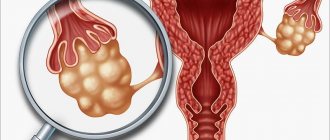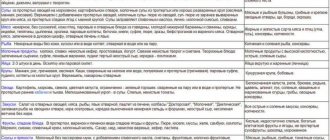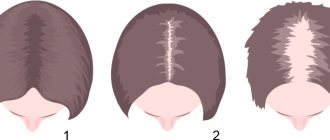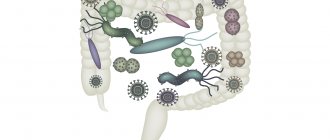The period from November to April accounts for about 95% of cases of rotavirus infection in children and adults. It is most difficult for children under 5 years of age. Their body is characterized by low acidity of the gastric juice produced and the lack of the ability to actively resist viral infections. The rotavirus got its name from the characteristic shape of the vibrio, which looks like a wheel with a well-defined rim (translated from Latin, rota means “wheel”).
How to distinguish rotavirus?
The name “intestinal flu” has been assigned to rotavirus infection. This is explained by the similarity of its symptoms with the flu: both begin acutely, with a sharp increase in temperature to 39°. But the infection, which is not related to influenza viruses, is also characterized by dysfunction of the digestive system. Therefore, typical symptoms of rotavirus are:
- diarrhea;
- nausea and vomiting;
- pain in the navel and above;
- characteristic “rumbling” in the stomach.
A sick baby becomes lethargic, irritable and loses interest even in his favorite food. Vomiting, diarrhea and fever are accompanied by other diseases. Parents need to remember that the consequence of rotavirus infection is particularly severe diarrhea - with diarrhea up to 20 times a day for 3-5 days. At first, the stool has a mushy appearance and a yellowish tint, but gradually becomes more watery and discolored.
How do you get infected with rotavirus?
Absolutely all children are susceptible to infection. The likelihood of infection is not affected by the level of hygiene and type of behavior of the baby, or the quality of food and water. Rotavirus is extremely contagious, belongs to the “dirty hands” category and is transmitted through the oral-fecal route. Children, as a rule, become infected from adults, who usually suffer from a mild form of the disease, in most cases not even paying attention to a mild, quickly passing bowel disorder. For babies after six months, actively crawling on the floor and grabbing all surrounding objects with their hands, it costs nothing to catch an infection.
Once in the body, the virus settles in the cells of the mucous membrane of the small intestine and stomach, causing inflammation - enteritis, gastroenteritis. Typical symptoms of the disease are explained by the destruction of epithelial villi and disruption of the production of enzymes necessary for the digestion of food.
After recovery, rotavirus does not leave any unpleasant consequences in children. However, for weakened children it can become very dangerous. Therefore, at the first suspicion of “intestinal flu,” the child should be shown to a good paid pediatrician.
Rotavirus infection
Rotavirus infection (rotavirus gastroenteritis or “intestinal flu”) is an acute viral disease that is characterized by symptoms of general intoxication (weakness, lethargy, decreased appetite up to its complete absence, pale skin), damage to the gastrointestinal tract, and dehydration. Rotavirus is the most common causative agent of gastroenteritis in young children, ranking second after acute respiratory infections in all countries of the world.
Children aged 1 to 5 years are most often susceptible to this infection, although the most striking clinical manifestations usually occur in children from 6 months to 2-3 years. However, infants also suffer from rotavirus infection, but they are to some extent “insured” from it, since they have maternal antibodies (so-called passive immunity), which prevent the virus from entering the body. Rotavirus infection has a pronounced seasonality: the incidence increases in the autumn and winter months, remaining at a high level in December-March. Winter seasonality is associated with better survival of rotaviruses in the environment at low temperatures (even repeated freezing does not destroy the virus). However, the virus loses its infectivity when boiled and treated with 95% alcohol. Considering that the virus is widespread, it is, unfortunately, not very difficult to “catch” it. The source of infection is only humans. The pathogen is excreted in feces for up to 3 weeks (usually 7-8 days from the onset of the disease) with maximum excretion in the first 3-6 days. Most often, infection occurs through the fecal-oral route (through household items, cooked food, etc.), that is, we can say that this is a disease of “dirty hands.” Another frequent and most common route of infection is through water (river, well and tap water). From the very beginning of the disease, rotavirus affects the mucous membrane of the stomach and small intestine, which leads to impaired digestion of food, the development of severe diarrhea and dehydration.
HOW DOES ROTAVIRUS INFECTION START AND MANIFEST?
The incubation period of rotavirus infection lasts from 12-15 hours to 5-7 days (usually 1-2 days). The disease begins acutely. A detailed picture of the disease is formed within 12-24 hours from the onset of infection. From the very beginning, the disease can manifest itself as a slight runny nose and sore throat, so rotavirus is often mistaken for a banal acute respiratory infection. However, this is just the beginning. Then the classic triad of symptoms of rotavirus infection appears.
Fever. The temperature reaction usually does not exceed 38-39°C and lasts about 2-4 days. It may be accompanied by symptoms of intoxication. Vomiting. One of the first and often leading signs. It usually precedes or occurs simultaneously with diarrhea. Repeated vomiting is typical, less often - repeated, but it is always short-lived - about 1-2 days.
Intestinal dysfunction. Characterized by copious, liquid, mushy, often watery, foamy yellow stools, usually without pathological impurities (blood and mucus). Sometimes there may be a short-term yellow-greenish coloration of feces and an admixture of clear mucus. The frequency of stool is usually determined by the severity of the disease and can range from 2-5 times a day in mild cases and up to 20 or more times in severe cases. The duration of diarrhea usually does not exceed 3-6 days. Intestinal dysfunction is accompanied by abdominal pain, which can be of varying degrees of severity, diffuse or localized in the upper half of the abdomen. Episodes of cramping pain may occur. Many children experience bloating and rumbling in the abdomen.
In the vast majority of cases, the course of rotavirus infection is favorable and recovery occurs on the 5-7th day. Immunity after rotavirus infection is unstable and lasts for a short period of time. This means that once a disease has been contracted, it will not protect your baby from subsequent infections, but with adequate treatment and timely consultation with a doctor, complicated forms of the disease can be avoided.
TREATMENT OF ROTAVIRUS INFECTION
The main goal in the treatment of rotavirus infection is to combat dehydration (that is, restoration of the volume of lost fluid) and intoxication. These two main components of the disease very often lead to dysfunction of vital organs, primarily the kidneys and organs of the cardiovascular system, which can cause serious complications. Oral rehydration (replenishment of lost fluid through the mouth) is currently widely used. In the pharmacy chain you can purchase ready-made dry powders that are easy to use: they should be diluted in the suggested amount of water.
It is difficult to calculate the volume of oral rehydration on your own, so you should not self-medicate! You definitely need to see a doctor! Enterosorbents, probiotics, prebiotics, enzymes, antidiarrheals and other drugs are also used for treatment. There is currently no specific treatment for rotavirus infection.
Diet for rotavirus infection:
- Feeding the child should begin after 4-6 hours of oral rehydration;
- In no case should you give your baby water-tea breaks or “starvation” diets;
- during the acute period of the disease, milk and dairy products, as well as foods rich in carbohydrates (sweets, etc.) should be excluded from the diet;
- if the child is bottle-fed, he should be offered fermented milk, low- and lactose-free formulas;
- the frequency of meals can be increased, but its volume, on the contrary, needs to be reduced;
- food should be easily digestible, age-appropriate and sufficiently high in calories;
Depending on the age, severity and course of the disease, adequate nutrition is restored by 4-6 days.
PREVENTION OF ROTAVIRUS INFECTION
The main prevention of rotavirus infection is compliance with sanitary and hygienic rules. Careful care should be provided for young children, including the treatment of pacifiers, toys, dishes, linen, and hands. Avoid contact with sick people and virus carriers, and limit the child’s visits to public places with large crowds of people. It is also necessary to carefully observe the sanitary and hygienic regime in the process of preparing food and storing food. The living space should be frequently ventilated and wet cleaning must be carried out. Immune drugs can be used as preventative and therapeutic agents (after consulting with a doctor!).
Dear parents! Timely seeking medical help will help your child avoid complicated course of the disease!
NOT. Baranova Head of the Infectious Diseases Department
Novopolotsk Central City Hospital
How dangerous is rotavirus infection for children under 5 years of age?
The incubation period of rotavirus is short, only 1–4 days. Therefore, viruses very quickly destroy the normal functioning of the intestines, forcing it to pump out water and microelements from the baby’s body - in particular, potassium and magnesium, which are necessary for the normal functioning of the heart. This leads to a rapid increase in weakness.
To recover and reduce the symptoms of intoxication, the child must drink plenty of fluids and replenish lost minerals. But at the same time you have to drink literally 50 ml, since taking the same rehydron in large volumes can provoke vomiting. High temperature also significantly worsens the condition of the baby.
Treatment of rotavirus in children
There are no specialized pharmaceuticals for the treatment of rotavirus infection. Treatment should be aimed at compensating for the mineral salts and fluids lost by the body so that the cardiovascular and urinary systems are not damaged. In order not to risk the child’s health (especially if a child under 2 years old is sick), it is best to call a doctor at home. A good pediatrician will confirm or refute the diagnosis, give adequate recommendations and monitor the baby’s condition so that the disease does not lead to undesirable consequences.
How to treat rotavirus?
Fasting, drinking and absorbents.
- The intestines and stomach need a food break, which should last at least 4-6 hours, and in severe cases - up to a day. After about 3–4 days, if the dynamics are positive, nutrition can be gradually restored without overusing carbohydrates and plant fiber. Even when things are getting better, there is no need to give milk (due to temporary lactose deficiency), raw fruits and vegetables, potatoes, or sweets for 8–10 days.
- When treating rotavirus in children under one year of age, they should be fed breast milk or formula as usual, but the portion should be reduced by half.
- During the food break, the baby must be constantly fed with saline solutions to avoid dehydration. The ready-made solution is purchased at the pharmacy, but it can also be prepared at home: per liter of boiled water - half a teaspoon of salt and 2 tablespoons of sugar. You can also drink weak tea, fruit juice, dried fruit compote.
- The sorbents approved for children are activated carbon (1 gram of carbon per 1 kg of weight), smecta, enterosgel.
Self-administration of antibiotics is strictly prohibited. Not only are they not designed to treat viral infections, but they also seriously change the composition of the intestinal microflora.
Universal diet for children
What diet should form the basis of a child's diet? Gastroenterologists are convinced that the most universal option that can be used to feed healthy children is table No. 5.
This diet is usually used for diseases of the liver and pancreas, but it provides sufficient calories and normal levels of proteins and carbohydrates, with limited fat and salt.
Table No. 5 provides for fractional meals 5-6 times a day, while long breaks between meals are not allowed and spicy, sour, canned and fried foods are prohibited.
When creating a menu you can use:
- Biscuits, homemade baked goods in limited quantities. Fresh bread and puff pastries are prohibited.
- Vegetable soups, with the addition of cereals, borscht. Mushroom, meat and fish broths are excluded.
- Beef, chicken, turkey, and boiled or baked rabbit. At the same time, duck meat and any offal are prohibited. Children's diets should also not contain sausages and canned meat, both industrially and home-produced.
- Boiled or baked fish. Smoked fish, salted fish and canned food should be excluded.
- Dairy products. At the same time, try not to buy yoghurts in stores, but prepare them at home using starter culture. Sweet cereals with milk are allowed. At the same time, limit the presence of cream, full-fat milk and cheese in your diet.
- Steam omelette. Hard-boiled and scrambled eggs are prohibited.
- Raw, boiled and stewed vegetables. At the same time, we exclude fried, pickled and pickled vegetables from the diet.
- Compotes, jelly, juices from fresh fruits of not too sour varieties. It is worth choosing those gifts of nature that are common in your area.
- Marshmallows, marmalade, nougat. We exclude chocolate from the diet.
For example, for breakfast you can serve your child cottage cheese with fruit and tea with cookies. After two hours, offer your baby a baked apple. For lunch, prepare vegetable soup, porridge and steamed cutlets. The afternoon snack will consist of not too strong tea with sugar and cookies. Finally, your child will have boiled potatoes with baked fish for dinner.
How many days does rotavirus last?
In most children, with proper therapy, vomiting goes away within a day, and abdominal pain and diarrhea persist for 3–7 days. The immune system of the body receiving support begins to produce immunoglobulin A, which helps fight viral infection. But even on days 12–15 from the onset of the disease, the intestines are not yet cleared of viruses. Therefore, a child who is already feeling relatively well continues to remain dangerous to others for about 4 weeks.
To prevent other family members from getting sick, it is necessary to observe basic hygiene standards: wash your hands, boil children’s dishes and cutlery, and do not forget about wet cleaning of the apartment. At the end of the disease, a certain amount of antibodies will be formed in the body, which will help transfer the rotavirus much easier the next time.
Causes
The causative agent of rotavirus infection in children and adults is rotavirus, which has the ability to survive even when treated with potent disinfectant solutions. In the feces of a sick person, its vital activity persists for 7 months, in environmental conditions - for more than a month. The infection is transmitted from a carrier or a sick person through the fecal-oral route through water, food and household items, especially when the sanitary and hygienic condition of the premises is unsatisfactory.
Patients at risk for rotavirus include:
- childhood;
- with disturbances in the functioning of the immune system, when it is suppressed;
- with chronic intestinal diseases;
- with violations in the diet, as well as when changing baby food;
- working or visiting large groups;
- not observing the rules of personal hygiene.











